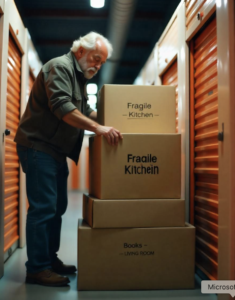
When you’re planning a move, storage often becomes part of the equation. Maybe your new home won’t be ready for a few weeks. Maybe you’re downsizing and unsure what to keep. Or maybe you simply want to declutter while staging your home to sell. Whatever the case, having the right storage solution—short-term or long-term—can make the entire moving process smoother and far less stressful.
We’re breaking down what you need to know about your storage options, what to look for in a facility, and how to protect your belongings along the way.
Short-Term vs. Long-Term Storage: What’s the Difference?
When it comes to storage, there are two ways to think about solutions: short-term and long-term. The main distinction comes down to how long you plan to store your belongings:
Short-term storage usually covers a few days to a few months. It’s ideal for:
- Temporary housing between leases or closings
- Delayed move-in dates due to renovations or construction
- Staging your current home for sale and needing to remove extra furniture
Long-term storage is best for items you don’t plan to access anytime soon. This could include:
- Belongings from a downsizing move
- Sentimental or seasonal items without a place in your new home
- Storage during military deployment or extended travel
Many storage facilities offer flexible contracts, so you’re not locked into a time frame, making it easy to extend your rental if needed.
What to Put in Storage During a Move
Choosing what to store (and what to keep with you) depends on your timeline and daily needs. A good rule of thumb is that if you won’t need it in the next few weeks, it’s probably a candidate for storage.
Items commonly stored include:
- Large furniture pieces
- Holiday decorations and seasonal gear
- Kitchen extras, like serving sets or slow cookers
- Off-season clothing
- Business files or equipment not currently in use
Items to keep on hand:
- Important documents (passports, lease/mortgage papers)
- Daily toiletries and medications
- A few changes of clothes
- Electronics and chargers
- Kids’ or pets’ essentials
How to Choose a Reliable Storage Facility
With so many storage options available, it’s worth finding one that fits your needs. Here’s what to consider when choosing your storage partner.
Security and Safety
Look for a facility that offers:
- Video surveillance
- Gated access or keypad entry
- On-site staff or regular monitoring
You’re trusting them with valuable belongings, so peace of mind matters a lot.
Climate Control
Humidity and extreme temperatures can damage furniture, electronics, documents, and fabrics. If you’re storing anything sensitive, opt for climate-controlled units.
Cleanliness and Accessibility
A clean, well-maintained facility reduces the risk of pests and mold. Also, consider how easy it will be to access your items. Some facilities offer 24/7 access, while others have limited hours and may require planning to access.
Smart Packing Tips for Stored Belongings
Whether you’re storing items for a few weeks or several months, packing them properly can prevent damage and make it easier to find things later.
Here’s how to pack with storage in mind:
- Use sturdy boxes or plastic bins with secure lids
- Label clearly on multiple sides with the room and contents
- Wrap fragile items in packing paper or bubble wrap
- Disassemble furniture and store hardware in labeled bags
- Elevate boxes off the floor using pallets to prevent water damage
- Create a storage inventory so you know what’s in each box without digging
Avoid using plastic bags, which can trap moisture and lead to mildew.
Planning for Cost and Convenience
Storage pricing varies based on location, unit size, features like climate control, and the duration of your rental. To keep costs down:
- Declutter before packing to store only what you need
- Compare prices from a few facilities before committing
- Look for bundled moving and storage services if you’re hiring a moving company
You may also find better rates by avoiding peak moving season (typically summer months) or choosing a slightly smaller unit with smart packing.
The Bottom Line: Storage Can Simplify Your Move
Moving is rarely as straightforward as packing up one day and settling in the next. Storage helps you manage the in-between, giving you space, flexibility, and time to make your transition smoother.
Whether you need short-term storage for a few weeks or a longer solution while you figure out what comes next, the right plan can ease the stress and protect your belongings.
If you’re moving in or around Northwest Arkansas, Winter Moving & Storage offers secure, climate-controlled storage options that work with your timeline and needs. Get in touch today for a free estimate.







1 Comment
Great breakdown of how short-term and long-term storage makes moving easier. The tips on choosing a secure and climate-controlled facility are especially helpful. Here in Tasmania, we rely on Budget Box for flexible mobile storage during moves—it’s delivered to your doorstep and kept safely in a monitored facility. Your guide makes it clearer why the right storage partner can reduce stress during any relocation. Thanks for sharing!